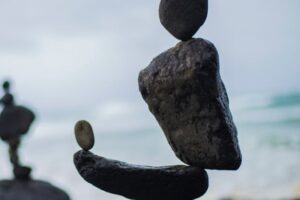The Least Important Thing
Not playing games here —
it’s not what you think it is —
“in truth, IT is you.”
In the last segment of UnMind, we looked at the implications of Master Dogen’s expression, “the most important thing in Buddhism,” from Fukanzazengi, the set of instructions for zazen he composed after returning from China. We speculated on what he could possibly have meant, by singling out one of the many points he made in the text.
I suggested that it may be more useful to consider the “don’ts,” rather than the “do’s,” such as: not thinking, not interacting, and not distinguishing between the absolute and relative, rather than speculate upon a single bumper-sticker summation of his broader points, as the singular, “main thing to do.” In other words, maybe he is pointing at something holistic, in the visceral realm, rather than the intellectual.
This is in keeping with Buddhism’s major teachings — that their meaning will be found in our direct experience on the cushion and in daily life, rather than in words, which can point at the truth but fail to express it in any comprehensive sense.
So when we consider the least important thing in Buddhism, it may be helpful to turn to the written record of the spoken teachings of Buddha himself, beginning with the First Sermon, reputed to be what he had to say to the five ascetics he had been training and traveling with at that point in his spiritual quest. It starts out with come “don’ts.”
In that original dharma talk, Buddha essentially dismisses the extreme lifestyles of the rich and famous on the one hand — self-gratification writ large; and that of the ascetics themselves on the other, who had turned away from Siddhartha after witnessing him drinking goat’s milk, violating their high standard of discipline, including virtual starvation. Buddha had landed in the Middle Way, after a night of extreme introspection.
Here we have to reiterate that “extremism in the pursuit of moderation is no vice.”
In articulating the Middle Way between the usual pursuits of the lay hoi polloi and the monastic minority, Buddha indicated the futility of both lines of endeavor — self-gratification versus self-mortification. The most balanced and natural approach is nether to deny the cravings born of body, mouth and mind, nor to overindulge them.
This suggests an innate trust in basic human nature — or we should say buddha-nature — our original nature, which is untrammeled by the limits and demands of biological needs and societal norms. Not exactly the noble savage, but the natural sage: a person who lives freely within the bounds of nature as well as those of society. Mr. Natural.
Amongst the least important things in Zen would be concerns about our social identity. As one contemporary author’s mother told him, You would be a lot less concerned about what others think of you if you realized how seldom they do. We all see ourselves as the marquee character in our own movie, with all others playing supporting roles. The trouble is, everyone else sees their reality the same way, with us as the bit players.
While the most important thing, or things, about Buddhism will necessarily lie within the personal sphere, the least important will be found in the social sphere. Those in the natural and universal spheres will fall in-between. For example, it is more likely that we can safely ignore developments in society that may indirectly threaten our livelihood, safety and security — such as which party is currently in power — than we can those from natural and universal sources — such as climate change, pandemics, and asteroids.
The most important things in Zen revolve around personal applications of the method — zazen — and the results of such training in terms of its effects directly upon the body-mind as well as attitude adjustments regarding our misconceptions of buddha-dharma, and some that tend to have a halo effect upon social life.
One major overlap is the practice of patience. Sitting upright, straight enough and still enough for long enough, we are forced to become much more patient with ourselves, our general ignorance and the monkey-business machinations of the discriminating mind — citta in Sanskrit — which serendipitously sounds like Cheetah, Tarzan’s famous chimpanzee companion, making it easy to remember. Wisdom, or enlightened, mind — bodhi in Sanskrit — comes to the fore. Citta and bodhi, foreground and background mind, or analytical and intuitive mind, gradually or instantaneously, come into better balance: the original, unified mind, in which the apparent dichotomy is “not-two.”
Much like central and peripheral vision, which collaborate interdependently to make up the whole of the sense of vision, the two aspects of mind are not in opposition to each other. Not competitive, but complementary. The most important thing, then, would be to allow them to work in harmony. Vacillation from one to the other is the natural way that intelligence and consciousness work. The least important thing would be to worry about them as being antagonistic to each other. We do not have to “empty our mind of thoughts. In fact, if we try to, the monkey will turn into a 600-pund gorilla. We will lose that battle. Better to allow the monkey free range. I will wear itself out eventually.
When citta exhausts its frantic coping mechanisms, it will lie down and take a nap. Then bodhi can manifest as the balancing act. The posture becomes a comfortable stretch, the breath like a sigh of relief. By relinquishing control, we sink into equanimity.
The Buddhist jargon term that addresses centered balance, or settling into “calm abiding” (Skt. Shamata) — and is often defined as the platform for insight (Skt. Vipassana) — is Samadhi: usually capitalized to emphasize the veneration and importance it is accorded.
While I think that — as much as possible — we should endeavor to reduce or eliminate the jargonized nature of much of the written record, it may be clarifying to characterize the method of zazen and its effects in terms of different kinds of “samadhis.”
The first, the traditional form of the upright seated posture of the body in zazen, we might call physical samadhi — less stress, more equipoise, or equilibrium — basically coming into alignment with gravity.
The second, we might term emotional samadhi — less anxiety, more calmness. Since mind and body cannot separate, the most direct path to the “mind” is through the body.
The third, mental samadhi — less confusion, more clarity — particularly regarding the true meaning of buddha-dharma, what the teachings are pointing to in reality, which is only accessible within our direct experience. Experiential truth is the only truth in Zen. But we can misinterpret what we perceive. All perceived reality is virtual.
I propose that there is a fourth kind of samadhi, which I term social samadhi — less friction, more harmony — in relationships. This, of course, is what most people are looking for in the early stages of their meditative practice. But its manifestation is further down the road. It all begins with physical samadhi in zazen.
Amongst the least important things, one of the most important is to avoid creating expectations of your practice of zazen. Setting expectations is the way we approach most activities we associate with learning. We hope to learn something new, to find what is missing. But zazen, and its effects, is not really gaining something new, but remembering something long forgotten, and primordial: the natural posture, the natural breath, the natural state of mind. If we imagine that there is something fundamentally wrong with our mind, and that we have to “fix” it, then we are making a fundamental error, a categorical mistake, defined as “treating abstract concepts as though they had a physical location.”
There is nothing fundamentally wrong with our mind, or for that matter with the entirety of existence. The only thing wrong is our interpretation of reality, our own ignorance and uninformed opinions. As Master Pogo said, “We have met the enemy and he is us.”
The least important things are TBD – to be determined. In your practice and daily life.
As we close out the winter season of the old year and anticipate the opening salvos of the new year, let us remember that there is no such thing as a year, and practice with an open mind. Open to possibilities that lie beyond our imagination, and are right before, and behind, our original face. Don’t look in the mirror for it. It is the most important thing.
If you have any topics or areas of interest in Zen that you would like me to explore in 2025, please let me know. You know where I live.









